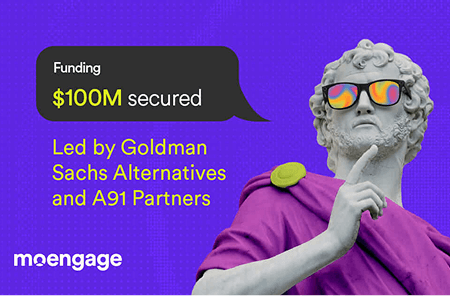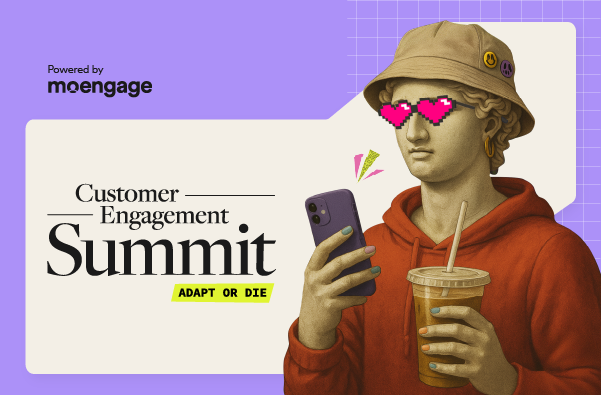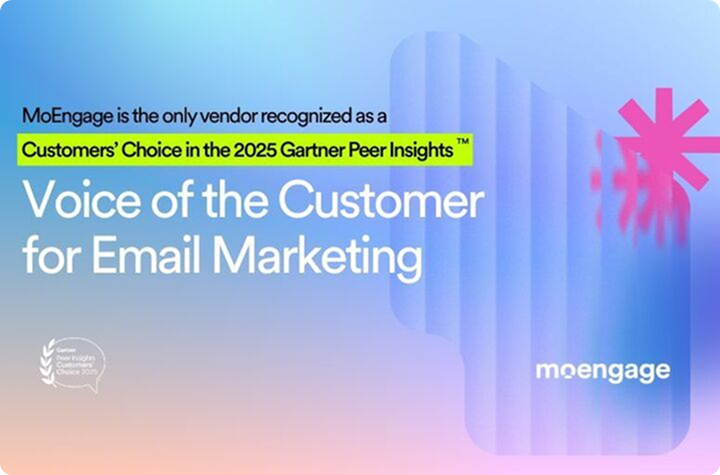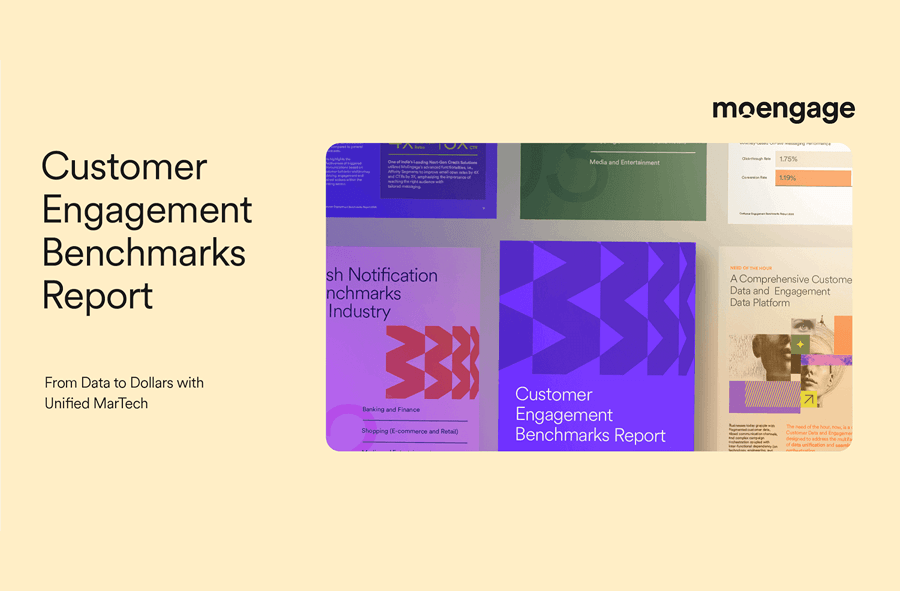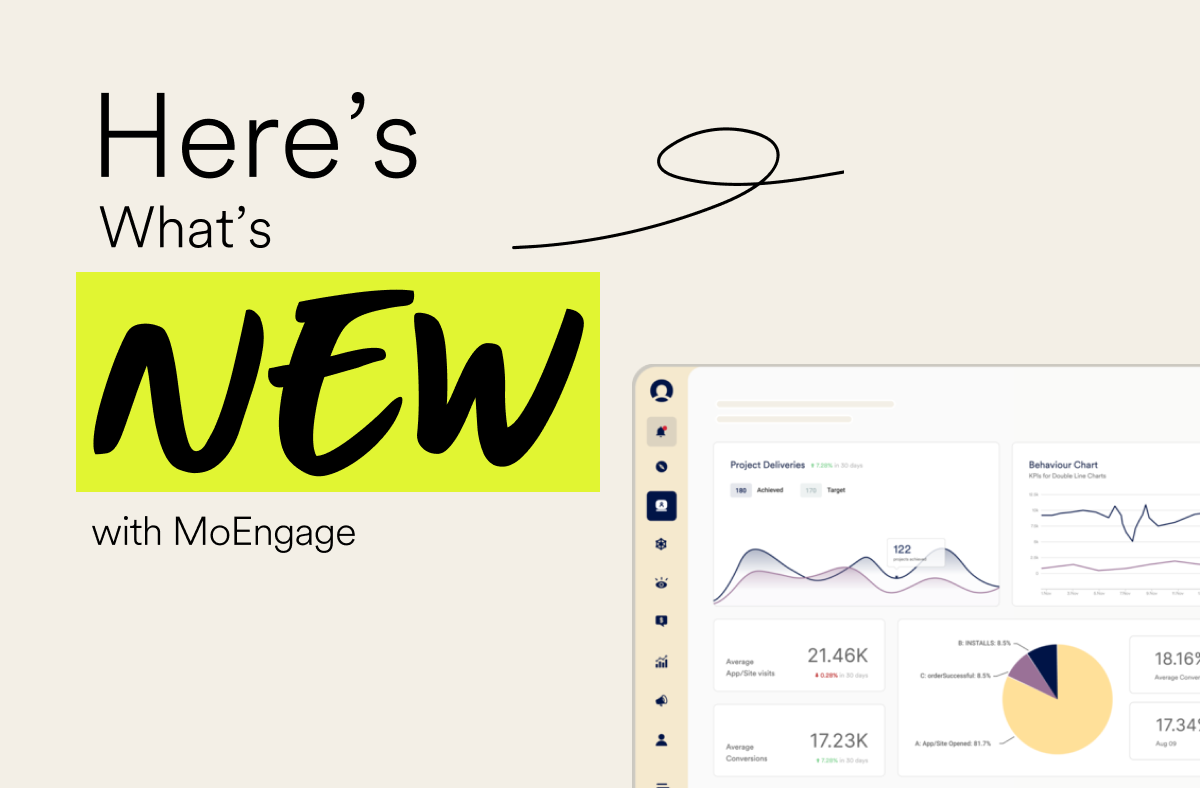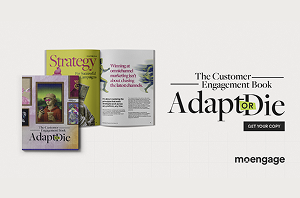Customer Engagement Guide: Strategies and Metrics for 2026
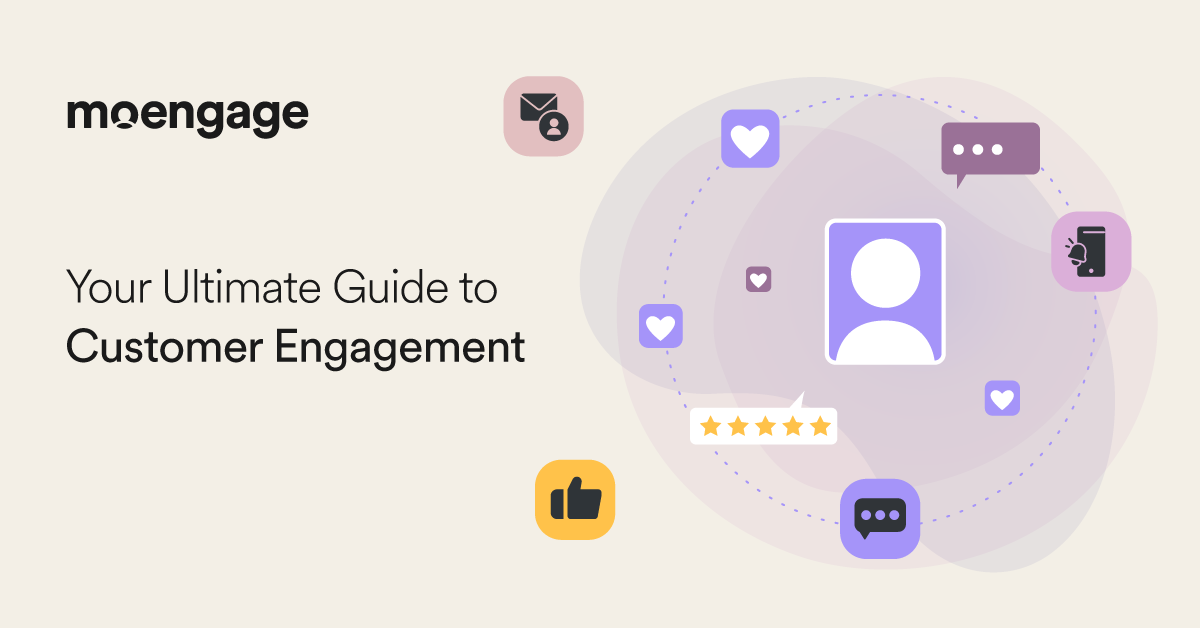
Reading Time: 20 minutes
Sometimes, it feels like every brand is competing for the same square inch of customer attention. This is why real customer engagement today comes down to understanding what customers need at that moment and responding in a way that feels natural, helpful, and human.
Rohit Agarwal, CEO at The Weather Company, captured this idea well at the Customer Engagement Summit:
The more we can know about our customers, the more we can anticipate what their next best action or next biggest need is, and then how we can super-serve that. For us, it’s about delivering messages at the right moment, in the right way, via the right channel.
And, in many ways, that is the core of customer engagement: creating simple, timely moments that feel personal without crossing into intrusive territory. In this blog, we break down how brands can consistently create more of those moments.
Customer Engagement Marketing: Definition and Fundamentals
We’re starting with the basics. Not because they are easy, but because many teams skip them and then feel lost when their customer engagement work refuses to fall into place.
What is customer engagement?
Customer engagement refers to the ongoing interactions a customer has with a brand across various touchpoints. It reflects whether they feel recognized, supported, and understood as the relationship develops through consistent, relevant, and genuinely helpful interactions that build trust over time.
In most cases, it’s a mix of behavior, timing, context, and a bit of emotion that’s hard to quantify. Some interactions come from the brand, some from the customer, and a few are routine but still meaningful. Engagement has many layers, and some of them show up quietly in places companies rarely look.
Many strong engagement programs originate from consistent communication that feels intentional, even when it’s not perfect.
Sometimes the customer finds value through a message or a feature. Sometimes they stumble into it. Either way, useful interactions tend to build upon one another and strengthen the relationship.
Who is responsible for customer engagement management?
There isn’t a single, universal owner for this function. Early-stage teams typically place engagement within marketing because campaign planning, retention thinking, and messaging are already in place. As companies grow, responsibility can shift toward growth teams when revenue metrics, such as customer Lifetime value (LTV) or reactivation, become more important on a day-to-day basis.
In product-led setups, engagement often behaves like a product responsibility. The work focuses on in-app messages, feature adoption, habit patterns, and understanding customer behavior within the product. The language shifts too, becoming less about communication and more about behavior.
You’ll see many titles connected to engagement management. Retention Manager, Director of Retention, Lifecycle Marketing Manager, Lifecycle Director, customer Engagement Manager, CRM Manager, Head of customer Experience, Growth Marketer, Product Marketing Manager, customer Success Lead, and even Product Manager in some cases.
Each role enters with a different angle. Some roles bring more data focus. Others care more about narrative or customer context. Companies decide the owner based on where they believe engagement should influence outcomes at their particular stage.
What does a customer engagement manager actually do?
The responsibilities of a customer engagement manager tend to spread across several areas:
- Planning and running multi-channel engagement campaigns
- Looking at lifecycle journeys and spotting friction points
- Designing onboarding, retention, and reactivation flows
- Studying behavioral data to see how customers respond across channels
- Working with product, growth, and support teams to build better touchpoints
- Running experiments on timing, messaging, segmentation and personalization
- Improving activation and adoption with the right kind of nudges
- Keeping the brand’s relationship with the customer steady, not only during transactions
- Managing CRM tools, engagement systems, and automation workflows
The list is extensive because engagement impacts nearly everything. The person leading it usually ends up spread across strategy, execution, and the softer skill of understanding how customers react. The work continues to expand as the company grows, and that’s part of why defining the role remains ongoing.
Customer Engagement vs. Customer Experience: Understanding the Differences
These two terms are often confused. The lines between them are thin enough that teams sometimes treat them as the same thing.
When that happens, the strategy leans too heavily toward one side. Maybe everything becomes about smoothening the experience while the engagement work drifts. Or the messaging gets all the attention, and the overall experience feels neglected. The difference is small, though still meaningful.
- Customer Engagement: Customer engagement refers to the ongoing interaction between a customer and a brand. Messages, clicks, replies, small signals, even silence at times. It’s about the behavior that shows whether the customer wants to stay involved. The activity itself becomes the indicator.
- Customer Experience: Customer experience refers to the overall impression a customer forms as they navigate through a brand’s world. Website, product use, support, store visits, and all the tiny moments in between. It’s shaped by how the whole environment feels to them, even when they aren’t doing anything active.
How they work together
A simple way to think about it: engagement feels like the conversation, while experience is the space where that conversation happens. One influences motivation. The other affects comfort and trust.
The strongest brands usually build both at the same time and let the two areas support each other. The edges between them may look close, but the work behind each is different enough that treating them separately makes everything clearer.
Why is Customer Engagement Important?
Customer engagement sits right at the center of how a relationship with a customer holds up over time. If it’s strong, the connection stays active. If it’s weak, the customer slowly drifts even when everything else looks fine on the surface. You can invest heavily in acquisition, design, operations, support, and still lose customers if the engagement layer doesn’t keep them involved.
5 benefits of customer engagement
The benefits of customer engagement become easier to understand when you consider how engagement influences both behavior and business results simultaneously.
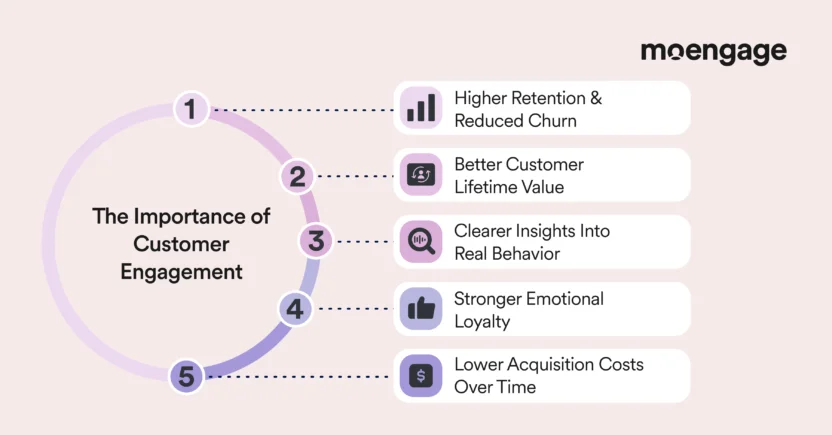
- Higher Retention and Reduced Churn: Engaged customers rarely disappear without warning. They stick around the edges, ask questions, browse, revisit, and leave small signals. Customer retention becomes less of a rescue mission and more of a continuation. A steady rhythm of interaction means fewer surprises when it’s time for renewal or repurchase.
- Better Customer Lifetime Value: When customers stay connected, they tend to explore more features and products. Purchases grow slowly, sometimes almost unnoticeably. Over time, these small shifts compound. Customer engagement marketing helps because it nudges value at moments that already make sense to the customer, rather than trying to push it abruptly.
- Clearer Insights Into Real Behavior: Customers who interact often reveal what’s actually happening. Their clicks, pauses, replies, and drop-offs tell you what is clear and what isn’t. Product, growth, and support teams rely on this because it grounds decisions in actual behavior rather than guesses.
- Stronger Emotional Loyalty: Customer loyalty doesn’t always come from discounts or feature sets. Many customers remain because the brand feels dependable and human. Thoughtful check-ins, timely reminders, and communication that feels relevant create a small emotional tie. It’s quiet but durable.
- Lower Acquisition Costs Over Time: Engaged customers tend to be more vocal. They refer their connections to your brand, leave reviews, and share recommendations. Over a long enough period, this reduces pressure on paid acquisition. It doesn’t happen instantly, though in most cases, engagement slowly shifts momentum toward more organic growth.
Common customer engagement challenges teams face
Even when a team genuinely cares about customer engagement, the actual work can feel like moving through a maze that keeps shifting. Tasks that appear simple on paper often become complicated in practice. And a few customer engagement challenges persist, recurring despite a company’s increasing experience and resources.
- Creating Messaging That Feels Personal at Scale: Most customers notice when a message feels mass-produced, even if the name and a few details look personalized. Balancing marketing automation with something that still feels human is harder than expected. Teams try to save time, but they also want to avoid sounding like a template. It typically requires a combination of clean data, some creative judgment, and ongoing adjustments.
- Understanding What a Customer Actually Meant: A click can mean curiosity, habit, or nothing at all. Silence can be disinterested or simply a busy day. Interpreting behavior gets messy because customers don’t act in neat patterns. Teams often have plenty of data but lack sufficient context, which slows down decision-making and creates more uncertainty than anyone likes to admit. As Aziz Vahora, Senior Director, Data Engineering at Poshmark, says, “Data without context is dangerous. You can mistake noise for signal and pivot too fast.” It’s a reminder that even strong data setups can mislead teams when the “why” behind an action isn’t clear.
- Tools and Channels That Don’t Work Together: Marketing runs one system. Product has another. Support uses something else. And none of these tools share information cleanly. This makes it challenging to create a unified view of the customer. When systems remain fragmented, engagement ultimately feels the same way. Customers notice the disconnect even when the team is trying its best.
- Getting the Timing Right: Timing sounds simple until you try to apply it. A useful message can still feel off if it lands at the wrong moment. A random message can work unexpectedly well if it happens to align with the customer’s rhythm. There isn’t a universal timing rule. Teams spend a lot of time making guesses, testing ideas, adjusting, and occasionally watching a well-intentioned message miss the mark.
- Aligning Teams Across the Company: Engagement affects marketing, product, growth, analytics, and support. Sometimes sales too. Each group brings its own priorities, and they don’t always move in the same direction. Without alignment, the customer receives mixed signals. Even strong engagement strategies start to wobble when teams aren’t working with the same assumptions.
Customer engagement can feel challenging, not because teams lack skill, but because the work often sits at the intersection of behavior, tools, timing, and internal coordination. When one area slips, the rest starts to shake. Once the core issues begin to settle, though, the improvements spread across the entire customer purchase journey in quieter, steadier ways.
3 Leading Strategies for Driving Customer Engagement
B2C brands don’t get endless chances to earn a customer’s attention. Customers jump between apps, close tabs, and forget even the most thoughtful messages within minutes.
Therefore, the strategies that truly strengthen customer engagement are usually those shaped around real behavior. Below are three approaches that tend to create steady, noticeable improvements in digital customer engagement.
1. Behavioral segmentation that responds to what customers actually do
Many B2C teams still rely on broad labels like “Interested in skincare” or “Added to cart once.” But real behavior shifts constantly. It changes with time of day, product availability, mood, and hundreds of little details you only catch by watching patterns closely.
Behavioral segmentation pays attention to what a customer is doing right now—what they browsed, where they froze for a moment, what they compared, and what they almost selected.
Why it works: It lines up with intent. A quick reminder on an almost-sold-out item nudges the customer at the right moment. Even something small, like revisiting a category twice, becomes a clear signal for a more tailored suggestion instead of another broad email blast.
How teams can do this:
- Track micro-actions such as page revisits, short sessions, wishlisting, and cart interactions
- Trigger outreach within minutes of intent rather than long after
- Use dynamic content blocks that shift automatically based on the customer’s latest activity
MoEngage gives teams a very detailed behavioral view, down to the session level, so you’re reacting to real activity instead of guessing. You can set up dynamic segments that refresh instantly and build “if-this-then-that” journeys without leaning heavily on engineering. The platform features AI-driven product recommendations and automated customer journeys that adapt to changing behavior.
2. Multi-channel orchestration that feels consistent, not repetitive
B2C customers hop between channels all day. They may see a push notification in the afternoon, skim an email before bed, and open the app on the weekend. Using multiple channels isn’t the challenge; keeping them coordinated is. A scattered approach creates noise. A planned rhythm feels natural.
As Scott Brinker, Founder and CEO at chiefmartec.com, points out:
There’s no finish line in martech. Every stack is in motion. The winners are the companies that see it as an operating system, not a project.
That perspective applies directly here: multi-channel engagement isn’t a setup you finalize once and for all. It’s a living system that needs ongoing alignment as customer behavior shifts.
Why it works: Repeated messages come off robotic. Coordinated ones feel deliberate. Push notifications can create urgency, emails can add context, and SMS can stay focused on practical updates. When each channel does its part, the customer doesn’t feel bombarded.
How teams can do this:
- Assign each channel a clear role in the omnichannel customer journey
- Use branching so the next step depends on what the customer did previously
- Set smart frequency caps to keep communication from piling up
As one of the most useful customer journey mapping tools, MoEngage offers a visual journey builder that integrates email, push, SMS, in-app, and web into one connected path. Every branch responds to real customer behavior. If they open something, the next step changes; if they ignore it, the journey adjusts. Channel-level analytics help teams see what’s effective and what’s causing fatigue.
3. Lifecycle programs that grow with the customer, not stay frozen
Many lifecycle programs get built once and then sit untouched for months. But B2C behavior rarely stays stable. A customer who buys twice needs different messaging than someone drifting toward churn. Even if they looked identical early on, their needs and patterns shift.
Why it works: Lifecycle engagement accounts for the fact that customers evolve over time. They explore, slow down, return, or disappear for a while. Messaging feels more relevant when it adjusts to the customer’s current phase, rather than the one they were in ages ago.
How teams can do this:
- Break the lifecycle into smaller stages (new > exploring > active > loyal > slipping > dormant)
- Add triggers for when customers move between those stages
- Refresh journey content quarterly to match seasonal trends and updated patterns
MoEngage makes lifecycle management flexible, allowing teams to update it continuously. You can build stage-based journeys that adjust automatically as customers shift between states. The platform’s AI engine, Merlin AI, predicts churn risk and suggests the next best course of action. Teams can run quick variations, track changes in engagement or drop-offs, and refine without rebuilding everything from scratch.
How to Analyze and Measure Customer Engagement
Tracking customer engagement usually sounds simpler than it is. Teams often start with the obvious numbers, such as clicks or email opens, and those help somewhat, but they rarely reveal the full picture.
What you really need is a set of signals that show how people behave over time, how their interests move, and where engagement slows down quietly before anyone notices. When these pieces sit together, things become easier to read and far more practical to act on.
Below are three core customer engagement metrics most teams rely on.

1. Active Users (DAU, WAU, MAU)
This refers to the number of customers who actually interact with your product or brand within a specified period, whether that is daily, weekly, or monthly. It reflects real activity. Not someone who created an account months ago and never returned.
Why it matters: Active Users help you see if your brand is part of someone’s regular routine or if they drop in once and disappear. A sudden dip in DAU typically indicates friction or confusion somewhere in the journey. Many teams break this down further by segments to see which groups are slowing down, then send timely nudges, recommendations, reminders or whatever tends to work for that segment.
How it supports engagement: When you know exactly when activity starts falling, you can step in early. Most teams prefer this because it reduces the chance of customers slipping toward churn without anyone noticing.
2. Engagement Rate (By Channel or Journey)
The engagement rate is essentially a measure of interaction signals. Opens, clicks, session depth, push interactions, and similar markers. It helps show how customers respond to a specific message or sequence.
Why it matters: Higher engagement typically indicates that the content is received reasonably well. Maybe the timing matches the customer’s habits. Maybe the channel fits better than others. When the rate starts dipping, it often means the customer’s intent or stage has changed, and the message no longer matches that shift.
How marketers use it: Test timing, such as morning vs. evening or weekday vs. weekend.
- Switch channels if a message is time-sensitive.
- Update creatives when patterns flatten.
Regular monitoring helps teams understand which types of communication actually keep customers engaged, rather than simply noticing something and moving on.
3. Customer Retention Rate
The retention rate indicates the percentage of customers who return over a specified period. It is one of the clearest indicators of whether your engagement efforts and product experience hold up over time.
Why it matters: Steady retention usually means the core loops are working. Customers understand the value, reach out when needed, and find enough reason to come back. When retention drops, interest often fades after the first few interactions or something in the experience becomes more challenging.
What it tells marketers: Retention makes the impact of onboarding, lifecycle flows, personalization, and timing more visible. Once retention improves, it often means the engagement strategy finally aligns with how customers behave in real-life situations.
How it strengthens engagement: Teams look at retention by cohorts to spot where the journey weakens. Sometimes the issue is activation. Sometimes it is product education. Sometimes customers need more support right after purchase. Cohorts make those gaps clearer.
3 Real-Life Customer Engagement Examples to Learn From
Seeing how leading brands engage their customers in the real world helps make the concept far more practical. Whether it’s personalization, community building, or seamless omnichannel journeys, these companies demonstrate how thoughtful engagement directly drives loyalty and revenue.
Below are a few detailed customer engagement examples and what marketers can take away from each.
1. Sephora: Creating a unified omnichannel loyalty experience

Source: https://www.sephora.com/BeautyInsider
Sephora has spent years treating every touchpoint as part of a single, seamless journey. Their Beauty Insider loyalty program seamlessly connects the website, mobile app, and physical stores, allowing customers to collect points, view recommendations, or redeem offers wherever they shop, through real-time push notifications. It feels consistent because everything syncs quietly in the background.
Why this works so well:
- Seamless cross-channel engagement: A customer can browse online, test products in-store, and purchase later on the app without losing context.
- Personalized rewards: Recommendations and offers are directly tied to past purchases, browsing behavior, and loyalty tier.
- High perceived value: Customers feel recognized and rewarded, not just targeted with generic promotions.
This demonstrates how consistency, supported by data, can transform a loyalty program into one of the strongest engagement engines.
2. Starbucks: Driving habit formation through personalized mobile journeys
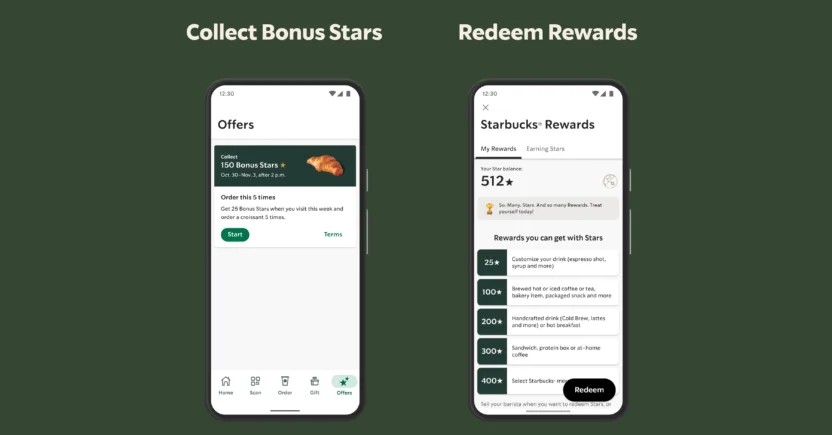
Source: https://play.google.com/store/apps/details?id=com.starbucks.mobilecard&hl=en_US
Starbucks utilizes its mobile app as a central touchpoint to foster repeat buying habits. Every order and preference feeds into a recommendation setup that keeps adjusting. Many customers check the app before they even think about what they want to drink that day. That’s how mobile customer engagement strategies work.
Why this works so well:
- Micro-personalization: Offers reflect individual buying patterns, like your preferred drink, time of visit, or seasonal favorites.
- Gamification: Bonus star challenges and streaks make ordering feel rewarding and fun.
- Real-time engagement: Location-based push notifications land exactly when customers are likely near a store or typically make a purchase.
Starbucks proves that engagement doesn’t always require big campaigns; even a small, behavior-based nudge can drive consistent revenue and deepen loyalty.
3. Nike: Building emotional loyalty through community and content
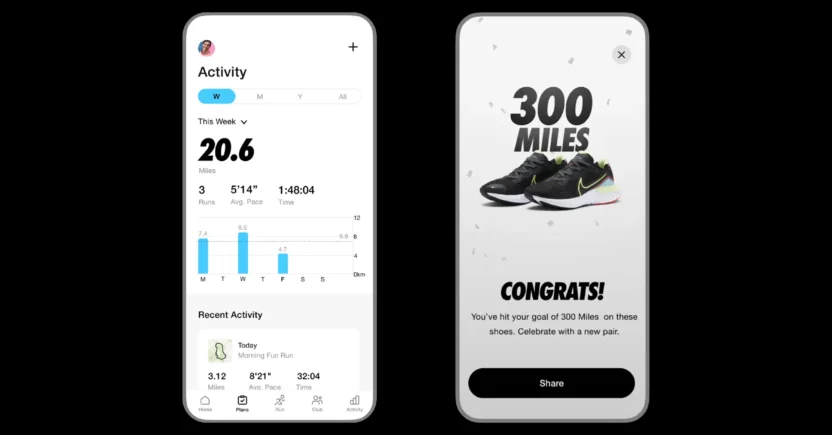
Source: https://apps.apple.com/us/app/nike-run-club-running-coach/id387771637
Nike goes beyond selling apparel. Through Nike Run Club and Nike Training Club, they create a space where users set goals, follow plans, track progress, and join global challenges. The apps stay relevant even on days when someone has no intention of shopping.
Why this works so well:
- Engagement with purpose: Users return because Nike helps them stay active and achieve progress.
- Community reinforcement: Leaderboards, challenges, and shared milestones make users feel part of a global fitness movement.
- Content-driven relationship: Workouts, tips, and training plans through rich push notifications keep Nike top-of-mind even when customers aren’t actively shopping.
Nike demonstrates how emotional connection and community-building can foster a deeper, more lasting form of engagement than discounts or promotions alone.
How to Evaluate Customer Engagement Platforms
Choosing a customer engagement platform ends up shaping more parts of the team’s workflow than people expect. The decision affects how quickly you can act on customer behavior, how journeys get built, and how much experimentation is even possible.
Some tools look nearly identical during demos, yet when you start working with them, the differences become pretty clear. It’s helpful to consider the capabilities that actually influence daily execution, rather than the features that sound impressive at first glance.
Most teams want a system that feels manageable and steady; something that reduces messy handoffs, clarifies your data foundation, and allows engagement programs to grow without becoming a maintenance burden. This is where foundational principles matter more than shiny feature lists.
As Khadyon Reid, Managing Director at Accenture Song, emphasized:
The number one issue we see with clients is buying tools before they have a strategy. Tech isn’t the strategy—customer outcomes are the strategy.
This distinction becomes obvious once teams start building real journeys and realize execution depends on clarity, not complexity.
Key features to look for in a customer engagement tool
Most teams want a system that feels manageable and steady. Something that reduces messy handoffs, clarifies your data, and allows engagement programs to grow without becoming a maintenance headache. These areas usually decide how well the tool fits.
- Omnichannel Orchestration: A single workspace for push, email, SMS, WhatsApp, in-app and web messages makes planning easier. When everything sits in one place, the customer gets a journey that feels connected. Not perfect every time, but usually more consistent than hopping between different systems. For B2C brands, this type of customer journey orchestration matters because timing shifts quickly and channel behavior rarely stays still.
- Real-Time Segmentation and Behavioral Targeting: Segmentation needs to adjust the moment a customer browses, pauses, buys, or starts slipping away. Many teams rely on this more than they admit because it keeps the messaging aligned with what the customer is doing right now. When the system reacts instantly, communication tends to align more closely with intent. It feels less like a broadcast and more like a relevant update.
- Analytics That Help You See What’s Happening: Clear dashboards and funnel views make it easier to understand customer patterns. Marketers should be able to check movement, drop-offs, retention, and cohort shifts without requiring a lengthy data pull. Some of the most useful insights come from simple patterns that show where customers hesitate. When you can see that quickly, adjusting the journey becomes much less complicated.
- Automation and Journey Building: The automation should allow real branching, multiple triggers, variations, and long-running journeys. In most cases, this is where teams save the most time. A strong customer journey map builder makes daily execution smoother and frees up room for experimentation. It also helps brands act early, rather than reacting when engagement has already slipped.
- AI Features That Support Personalization: AI in customer engagement can help with recommendations, churn prediction, message timing, and identifying intent. These features reduce manual work and keep personalization consistent even when volumes are high. For example, the system can pick up patterns that humans usually miss, especially around repetitive actions or early signs of drop off.
Having said that, evaluating a platform is primarily about understanding whether it enables you to clearly see customer behavior and act on it without friction. The right system becomes an integral part of how your teams work every week, rather than a dashboard that gets checked occasionally. You see this play out clearly in many examples, where the tools that fit well disappear into the background and make execution easier instead of heavier.
What to consider when choosing the right tool
After you get a sense of what these platforms offer, the difficult part is figuring out which one actually matches your business. Teams don’t operate at the same level of maturity. Data setups look different everywhere. Expectations around customer engagement marketing also change from company to company.
So, the decision ultimately comes down to fit rather than finding the absolute best in the market. It depends on where your organization stands right now and how quickly you expect things to evolve over the next few years.
- Your Brand’s Maturity and Team Structure: Some companies have full CRM or lifecycle units with clear ownership. Others have one person handling email, journeys, data pulls, reporting, and sometimes paid campaigns as well. The tool needs to align with the existing structure. When the platform is too advanced for a small team, they often avoid using half of its features. When it is too light, larger teams encounter limits very quickly. It helps to be honest about who will run the program day-to-day and what they can realistically maintain without slowing down.
- Your Data Readiness and Tech Stack Compatibility: Engagement tools rely heavily on the underlying data. Clean, connected data typically leads to cleaner execution. However, many companies are still in the process of fixing pipelines or standardizing events. If that is your situation, you need a platform that can still function without perfect data and grow along with your B2C martech stack. On the other hand, if you already have a Customer Data Platform (CDP), good product analytics, or a warehouse in place, the platform should integrate without blocking deeper behavioral or event-level work. Small gaps here become very visible once journeys get more complex.
- Vendor Reliability and Roadmap Stability: A customer engagement platform is not something most teams switch every year. It becomes part of the operating rhythm. It’s helpful to consider the vendor’s direction. How often do they ship improvements? Whether their updates solve practical engagement problems or just add shiny features that don’t help much. Many teams underestimate this and then get stuck with a product that stops evolving. Roadmap stability makes a difference over time.
- Migration Complexity and Long-Term Lock-In: Moving from one platform to another involves more than copying journeys. Data schemas, templates, event structures, and numerous small dependencies require rebuilding. Some tools make this manageable. Some make it painful and hard to exit later. It is better to evaluate migration effort early, especially if your organization expects to scale, add new channels, or run more sophisticated lifecycle work later. Flexibility matters more than it seems on Day One.
- Security, Compliance, and Data Governance: For B2C brands in sectors such as finance, retail, travel, or healthcare, channel-specific compliance rules, such as email compliance, can be stringent. The tool should support the standards required by your geography and industry. This includes privacy settings, retention controls, and the processing of data once it enters the system. Many teams only think about this when something breaks, which is usually too late. Doing the check upfront protects you from those situations.
For teams weighing a potential switch, the realities of customer engagement platform migration often reveal how much underlying work sits beneath the surface, such as data schemas, event structures, templates, and all the small dependencies that shape day-to-day execution.
And when you step back to evaluate options more broadly, thinking in terms of choosing the right enterprise customer engagement platform helps bring clarity to what actually matters: fit, flexibility, and how well the tool aligns with your operating model as it evolves.
Once you go through these angles, you start noticing how the landscape shifts and what future demands might mean for your team.
And that leads us to the next section on how customer engagement trends are changing and where the pressure is coming from next.
The Future of Customer Engagement: Important Trends and Stats
Modern customer engagement is not just about sending messages on time or across every channel. It’s becoming about anticipating needs, building relationships, and creating experiences that feel natural rather than mechanical.
AI, predictive analytics, and rising customer expectations are pushing brands to rethink how they interact. The numbers from recent research make this shift clear.
- 65% of senior executives say AI and predictive analytics are the top growth lever in 2025: Adobe’s 2025 Digital Trends report finds that nearly two-thirds of executives see AI as critical for growth. This is not about just automating campaigns. Predictive analytics allows brands to anticipate what a customer might need before they even signal it. For instance, a shopping app might suggest replenishment products just when inventory runs low, or trigger reminders based on past purchase patterns. Engagement here is proactive, almost preemptive. The challenge for teams is to make AI feel human and relevant while maintaining consistent context across channels.
- 61% of executives prioritize personalized experiences to drive growth: Personalization has evolved from a nice-to-have to a core strategy. Adobe’s data shows that brands can’t rely on broad segmentation or batch messaging anymore. customers expect communications tuned to their behavior and lifecycle stage. Yet personalization can backfire. Too aggressive, poorly timed, or irrelevant messages make customers feel tracked or manipulated. Done thoughtfully, aligned with predictive insights, it strengthens engagement and loyalty in ways generic messaging never will.
- 78% of consumers expect consistency across channels, but only 45% of brands deliver: Customers move seamlessly between web, apps, social media, email, and stores. Still, most brands operate in silos. Adobe finds that almost 8 out of 10 consumers want consistent messaging, but fewer than half actually get it. This gap matters strategically. Disconnected experiences reduce engagement and erode trust. Brands that unify journeys, messaging, and data can create a coherent story, making every touchpoint feel deliberate and connected.
- 73% of Chief Sales Officers prioritize growth from existing customers in 2025: Retention and upselling are becoming central. Gartner shows that nearly three-quarters of CSOs are focused here. Engagement is now a revenue driver, not just a marketing metric. Deepening relationships through personalized offers, lifecycle campaigns, or loyalty initiatives is often more cost-effective than acquisition alone. Teams that ignore retention risk leave revenue on the table while competitors capture loyal customers.
- 53% of customers say personalization has made them regret a purchase: Gartner reported that over half of consumers report feeling regret when personalization misfires, if recommendations feel intrusive, ill-timed, or irrelevant. This is a warning for marketers: more personalization isn’t automatically better. Subtle, context-aware engagement that respects a customer’s choices is key. Overdoing it can turn a potential loyalty driver into a liability.
Key Takeaways
Looking at these trends together, a few points become strikingly clear:
- Engagement is Moving from Reactive to Predictive: Brands that anticipate needs, rather than simply respond, will create more meaningful interactions and stronger loyalty.
- Consistency is Non-negotiable: Customers don’t see channels; they see your brand. Omnichannel coherence builds trust; inconsistency erodes it.
- Retention is the New Growth Engine: Deepening existing relationships through thoughtful engagement is now as important as acquisition, and often more profitable.
- Personalization must be Strategic and Context-aware: Too little and you’re ignored; too much and you risk alienating the customer. Effective personalization is subtle, intelligent, and empathetic.
- Campaign Impact Over Time: Rather than just measuring opens or clicks, brands need to analyze the long-term effects of campaigns on key business metrics, such as retention, revenue, and A/B test performance.
- Generative AI for Content and Segmentation: AI isn’t just for predictions. Brands can utilize generative AI for crafting messaging (emails, push notifications, SMS), segmenting audiences, creating visuals, and even driving campaigns to re-engage dormant users.
- Ethical Data Use Builds Trust: Privacy will remain a top concern. Techniques like PII masking and PII tokenization are key. customers trust brands that safeguard their data, and respecting that builds long-term loyalty.
These criteria indicate what successful engagement strategies will likely look like in the near future. To see how top brands are already applying these principles and what’s coming next, check out MoEngage’s latest analysis of 2025 engagement trends.
Your Ultimate Guide to Customer Engagement: Key Takeaways
Now that we’ve gone through what makes customer engagement work, here’s the gist: some brands just seem to understand their customers, while others barely register. It’s rarely luck, but it ultimately comes down to how they engage, anticipate needs, and make each interaction meaningful.
Want to see it in action? MoEngage’s customer engagement platform shows you the steps to follow. Take a closer look by trying a demo, and you might be surprised at how much more connected your campaigns could feel.

